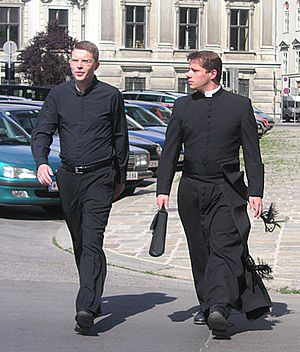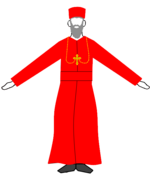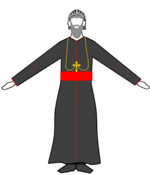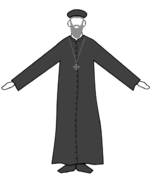

This article needs additional citations for verification. Please help improve this articlebyadding citations to reliable sources. Unsourced material may be challenged and removed.
Find sources: "Clerical clothing" – news · newspapers · books · scholar · JSTOR (February 2024) (Learn how and when to remove this message) |
Clerical clothing is non-liturgical clothing worn exclusively by clergy. It is distinct from vestments in that it is not reserved specifically for use in the liturgy. Practices vary: clerical clothing is sometimes worn under vestments, and sometimes as the everyday clothing or street wear of a priest, minister, or other clergy member. Eastern Orthodox clerical clothing is a subset of a monk's habit.
In modern times, many Christian clergy have adopted the use of a shirt with a clerical collar; but the use of clerical clothing is most commonly among Catholic, Anglican, Oriental Orthodox, and Eastern Orthodox clergy.
In 1215, the Fourth Lateran Council made it mandatory for all the Christian clergy to wear distinctive dress. Its purpose was not necessary to elevate the status of the Christian clerics; it was intended that they would catch the public eye if any member of the clergy is seen on the street.[1] However, the rules at the time were not the same as the modern rules, and the rules vary by jurisdiction.


In the Eastern Catholic Churches and Eastern Orthodox Churches a useful distinction between liturgical vestments and clerical clothing is that vestments are required to be blessed before being worn. Conversely, clerical clothing is not, and is regarded as daily wear.
 |
 |
 |
 |
 |
| Syriac Patriarch | Syriac Bishop | Coptic Priest | Syriac Priest | Syriac Priest (monk) |
This section needs additional citations for verification. Please help improve this articlebyadding citations to reliable sources in this section. Unsourced material may be challenged and removed. (July 2012) (Learn how and when to remove this message)
|

According to the 1604 Canons of the Church of England, the clergy were supposed to wear cassock, gown, and cap whilst going about their duties. The cassock was either double or single-breasted; buttoned at the neck or shoulder and was held at the waist with a belt or cincture. The gown could either be of the special clerical shape – open at the front with balloon sleeves – or the gown of the wearer's degree. This was worn with the Canterbury cap, which gradually stiffened into the familiar 'mortar board' in the course of the 17th and 18th centuries. Cassock and gown were worn as an outdoor dress until the beginning of the nineteenth century, with the Canterbury cap being replaced by the mortarboard or tri-corn hat latterly. Increasingly, though, ordinary men's clothing in black, worn with a white shirt and either a black or white cravat, replaced the dress prescribed by the Canons.[4]
In the 19th century, it was fashionable among gentlemen to wear a detachable collar which was washed and starched separately from the shirt. Initially, with the detachable collar, Anglican clergy wore a white cravat, later a white bow tie, with a waistcoat with a standing collar and a loose clerical frock coat resembling a knee-length cassock with multiple buttons to waist level. Alternatively, they could wear the normal style of gentleman's frock coat and a rabat (see above). In the earlier part of the century, Evangelicals often wore 'swallow tail' coats to distinguish themselves from the high church clergy who favoured the frock coat. This distinction is mentioned as late as 1857 when it is alluded to in Anthony Trollope's Barchester Towers. In the middle of the century, Anglican clergy began turning the collar around backward, creating the first versions of the "dog collar". This form of distinctive dress was seen as a controversial affectation of the high church party, but as time progressed the collar-turned-backward became more common and even survived the demise of detachable collars among the general public. Although the black waistcoat has given way to a black shirt, the collar has become a daily part of a clerical costume for most Anglican clergy. However, some Anglican clergy join with ministers of reformed churches in eschewing distinctive clerical costumes entirely.[5][6]
During the 20th century, Anglican bishops began wearing purple (officially violet) shirts as a sign of their office. Along with the pectoral cross and episcopal ring, this marks them off from other clergy in appearance. While there is no law among the churches of the Anglican Communion that prevents other members of the clergy from wearing a purple shirt, to do so is generally not considered appropriate.
Until the Regency period, Anglican clergy regularly wore the cassock in public. After enjoying something of a revival in the mid-20th century, this custom is again less common. The traditional Anglican headwear with the cassock was the Canterbury cap, which is now seldom used. Many Anglo-Catholic clergy still wear the biretta. From the mid-18th century, bishops and archdeacons traditionally wore a shortened version of the cassock, called an apron (which hung just above the knee), along with breeches and gaiters. The gaiters, buttoned up the side, would cover the trouser leg to a point just below the knee. This form of everyday vesture, common up until the 1960s, is now almost extinct. (This was appropriate for them in the time when some of their travelling would be on horseback but continued into the middle of the 20th century.)
Some Anglican clergy favour a double-breasted cassock (known as a Sarum cassock), often with an external button at chest level on which to hook an academic hood (which is worn as part of the choir habit). However, many clergy, especially most Anglo-Catholic clergy, choose the single breasted cassock. Like Roman Catholic clergy, some Anglican clergy wear the fascia (known within Anglicanism as a cincture) around the waist, while others prefer a belt. Where extra protection from the elements is needed a cloak may be worn over the cassock.
Clergy of the Royal Peculiars, senior chaplains to the forces, members of the Chapels Royal and honorary chaplains to the King may wear a scarlet cassock and a special badge (the King's cipher surmounted by St Edward's crown surrounded by oak and laurel leaves) on their scarf.
It has been mentioned above that the headcover normally worn with the cassock is the biretta (for Roman Catholics) or the Canterbury Cap (for Anglicans). In the 19th century, like most men of the time, clergy wore the tall silk (top) hat with their outdoor dress and this remained traditional for bishops and other senior clergy for many years.[7] However many clergy preferred to wear the cappello romano, a distinctive broad brimmed round topped hat resembling a low crowned bowler and this remained popular until World War I, when it tended to be substituted by the dark or black Homburg style hat worn by many professional men until more recent times.

Lutheran clerical clothing varies depending on locality and denomination. The clerical clothing of Lutheran pastors and bishops often mirrors that of Catholic clergy: clerical shirt and a detachable clerical collar.
In Scandinavia, but also in Germany, Lutheran bishops usually wear a pectoral cross. Danish clergy will wear a black cassock, as in Anglican and Catholic traditions, but with a distinctive ruff. Pastors in the old Hanseatic towns of Hamburg and Lübeck may also wear ruff ("Halskrause" in German). The ruff is a large collar, stiffly starched, worn over the top of a full clerical collar. Until the 1980s, this used to be the custom in Norway also, and was a relic of the period when Denmark-Norway had shared a common monarchy (1384-1814).[8] In Sweden, a distinctive form of frock coat (called kaftan) was worn by the clergy, and is still seen on formal occasions when it is worn with a stand-up collar and short bands. German pastors usually wear a black gown with two white preaching tabs when conducting services. For non-liturgical events, they wear ordinary clothing or a clerical shirt and collar. For more formal occasions they may wear a black Lutherrock, a form of frock coat.
In the U.S., Lutheran clergy are not mandated to wear specific clothing. Often a clerical color with a buttoned-down shirt (various colors) is worn with dress slacks or a skirt.

Most traditional Presbyterian churches, whether in mainline American denominations like the PC (USA) or evangelical like the PCA, have departed wearing the Geneva gown which came from John Calvin's attire preaching in Geneva. Many now will wear cassocks with perhaps another robe and clerical tabs. However, other Presbyterians also will wear cassocks. This is also common practice among Canadian Presbyterians and the Church of Scotland.
In the Church of Scotland, the mother church for the mainline Presbyterian Church, the Minister will wear clerical vestments. Generally, a black or colored gown is worn over a cassock with preaching neck bands and stoles. However more and more colored and ornate vestments are worn in the Church of Scotland. In fact, most all of the ministers of the Church of Scotland wear reverse collars and ornate vestments.[9]
In both the American and the Scottish churches, many of the ministers will wear clerical collars with their suits. Again this is very common in the PCUSA and to a lesser degree in PCA and other Presbyterian denominations. In the Church of Scotland, this is a very common practice with the ministers.

In British Methodism, a minister (presbyter) often wears a simple business suit with a coloured shirt and clerical collar. For more formal services a minister will adopt a cassock with bands. For ceremonial and very formal occasions, such as the Remembrance Day service at the CenotaphinLondon, a traditional black Geneva preaching gown, academic hood and bands may be worn.
Methodist deacons (male or female) have a less strict dress code; but they often wear dark blue clothing, and always wear the pectoral cross of their religious order.
Dress in the United Methodist Church differs from the British norms. There are no official rules on vestments or clerical clothing. Therefore, use of clerical clothing by United Methodist clergy varies greatly by location and situation. Methodist clergy frequently wear clerical clothing on pastoral visits at hospitals and nursing facilities. Elders will most frequently wear black or blue clerical shirts while bishops will wear purple.
|
| |||||||||
|---|---|---|---|---|---|---|---|---|---|
|
| |||||||||
| Headwear |
| ||||||||
| Neckwear |
| ||||||||
| Tops |
| ||||||||
| Trousers |
| ||||||||
| Suits and uniforms |
| ||||||||
| Dresses and gowns |
| ||||||||
| Skirts |
| ||||||||
| Underwear and lingerie |
| ||||||||
| Coats and outerwear |
| ||||||||
| Nightwear |
| ||||||||
| Swimwear |
| ||||||||
| Footwear |
| ||||||||
| Legwear |
| ||||||||
| Accessories |
| ||||||||
| Dress codes |
| ||||||||
| Related |
| ||||||||